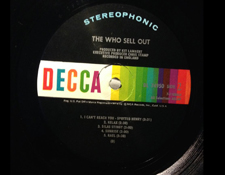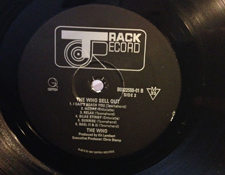It’s the time of year for saving money!
It’s always nice when a classic rock album returns to “in print” status. And with the Who celebrating 50 years of amazing music making, the reappearance of their catalog is indeed a blessing for fans who have not been able to find “new” copies of their favorite album in the stores. Sure, there are plenty of “used” copies out there in record collector land, but there is a certain type of customer who never likes buying used things.
 For those people, these reissues may well be the perfect solution.
For those people, these reissues may well be the perfect solution.
I will be upfront here and qualify this review with a couple of bits of information of interest to audiophiles: These new reissues, while very faithful to the original pressings, were made from a high resolution 24-bit, 96 kHz digital transfer. This is not necessarily a bad thing, mind you, and for all intents and purposes, the high-resolution files used are more than adequate for most fans of the band who might want to get new copies of the albums.
Of course there are those of us out there who would love to have a glorious transfer off the analog master tape done completely analog, like the Beatles did with their “In Mono” box set in 2014. Therein lies the rub: The Beatles still have the sort of fanatical fanbase that could justify the no doubt sizable commitment required to do an analog restoration like that.
Surely the Who still have that sort of massive following these days, right?
 Eh… I dunno ’bout that. It’s probably a much smaller subset than the Beatles. So creating the reissues from a convenient digital source is probably the more realistic thing for them to do (and probably all the label was willing to do at this stage of the game).
Eh… I dunno ’bout that. It’s probably a much smaller subset than the Beatles. So creating the reissues from a convenient digital source is probably the more realistic thing for them to do (and probably all the label was willing to do at this stage of the game).
Thus, you hardcore Who vinyl collectors out there can rejoice because this means your pristine original pressings are still relevant and valuable and valid to a certain subset of the marketplace (like me) who prefer original pressings from the ’60s.
All that said, for this review I only compared the new 180-gram stereo pressing to an original U.S. Decca Records stereo pressing from the ’60s. I opted to not compare it to the mono 200-gram reissue on Classic Records since that is a different animal entirely.
The Who Sell Out is an interesting and important transitional album for the band in that it was arguably their first higher-fidelity album, with all manner of psychedelic production touches including extreme left/right panning of sounds, backward tapes and treated instrument and voice sounds. They still hadn’t reached the sonic wonderment that was Quadrophenia or even Tommy, but still, it sounds good in all its 1967 paisley pop glory.
The new pressing reproduces the look of the original UK “Track Records” pressing. The album comes on lovely dark, dead-quiet thick vinyl in a nice audiophile grade antistatic-type plastic inner-sleeve. After playing side one of my Decca pressing I then put on the same side of the reissue; I followed the same process for side two.
 The first thing I noticed is that the reissue pretty much sounds the same as the U.S. Decca, mastered at about the same volume levels with an overall nice sound. I suspect that these both were probably sourced from the same copy of the master tape. If you listen to the Heinz Baked Beans section, you’ll hear some moments of “print through” — an anomaly resulting from the master tape imprinting magnetic information upon itself from another part of the tape — on both versions in the exact same spots. In this case it is the trumpet lines that are audible, just listen close and you’ll hear a little repeated echo of them there.
The first thing I noticed is that the reissue pretty much sounds the same as the U.S. Decca, mastered at about the same volume levels with an overall nice sound. I suspect that these both were probably sourced from the same copy of the master tape. If you listen to the Heinz Baked Beans section, you’ll hear some moments of “print through” — an anomaly resulting from the master tape imprinting magnetic information upon itself from another part of the tape — on both versions in the exact same spots. In this case it is the trumpet lines that are audible, just listen close and you’ll hear a little repeated echo of them there.
Out of curiosity I checked and this print through is NOT on the 2009 Deluxe Edition CD nor the 1995 single CD reissue… so… again, a different source may have been used for the creation of that reissue… and while those latter two sound pretty good, they are at the end of the day still CDs, fine for the car or on earbuds walking around town.
Anyhow, there are parts of this new reissue that I like a lot. The separation is a tad more distinctive than my original Decca pressing. The drums on “I Can See For Miles” sound pretty huge on this reissue. A track like “Sunrise,” one of Pete Townsend’s loveliest solo guitar & voice pieces is gorgeous with lots of nice round acoustic guitar tone in the mid and low ranges and just enough sparkle on the high end.
My only nit-pick is that when I turned the volume on my amplifier up while playing this reissue LP, the sound got a bit more angular to my ear, making for a less enjoyable listen. I guess that is some of the remnant of the digital nature of these transfers and the source tape used. This is particularly noticeable on rocking tracks like “Relax.”
I admit I am splitting hairs here, but this is the kind of thing that many audiophiles want to know about and tend to do — focusing on sonic minutiae that the average listener could care less about.
Most Who fans just want to rock out, if you know what I mean.
Certainly if I had an original UK Track Records pressing I would expect that pressing to sound markedly better than either of these discs.
So what is my bottom-line take on this? Well, if you are a serious audiophile Who fanatic, chances are you probably already have all the original albums which are already more than satisfactory to you, so you probably don’t need or want these. If you are a Who fan that got rid of all your albums back in the day when CDs were happening and you just want to enjoy some of your fave Who memories again on nice new pressings, these will be more than adequate for most people with basic stereo gear. If you are just getting back into vinyl, you’ll probably enjoy this new reissue just fine.
 Plus… with this version you get a reproduction of the groovy poster that came with original UK pressings back in the day (which is nice enough with a flat matte print style — different than the one in the Classic Records mono reissue which is glossy, with more vivid colors). Still, it’s a cool thing to have if you haven’t seen it.
Plus… with this version you get a reproduction of the groovy poster that came with original UK pressings back in the day (which is nice enough with a flat matte print style — different than the one in the Classic Records mono reissue which is glossy, with more vivid colors). Still, it’s a cool thing to have if you haven’t seen it.
For most Who fans, you really can’t go to wrong with this reissue (especially if you can find it on sale).






